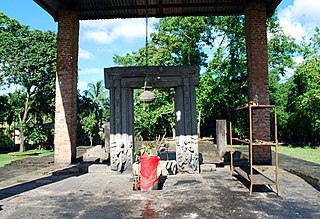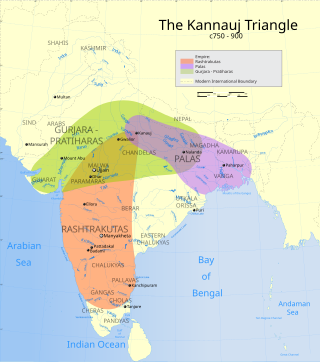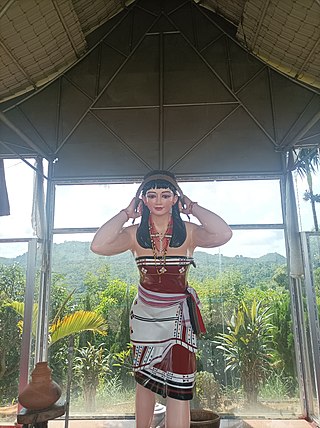Related Research Articles

Da Parbatia is a small village very close to west Tezpur, in the Indian State of Assam. In the village there are significant architectural remnants of an ancient temple of the 6th century overlying the ruins of another Shiva temple built of bricks during the Ahom period. Archaeological excavations done here in 1924 have unearthed a sixth-century antiquity in the form of a stone door frame with extensive carvings. The ruins of the temple built during the Ahom period are built over the ancient temple's foundations and are in the form of a stone paved layout plan of the sanctum sanctorum and a mandapa. This complex is under the jurisdiction of the Archaeological Survey of India and its importance and notability is recorded under the Ancient Monuments and Archaeological Sites and Remains Act 1958.

Mahendrapala was the fourth king of the Pala dynasty of the Bengal region of the Indian subcontinent. He was the son of Devapala and his queen Mahata.

Manipur River, also called Kathe Khyoung (ကသည်းချောင်း), is a river in India's Manipur state that flows into Myanmar, where it merges with the Myittha River, a tributary of the Chindwin river.

The Ningthouja dynasty, also known as Mangang dynasty, comprises the descendants of the kings of Manipur. Ningthouja literally means progeny of King. It has 125 extended families. It was apparently founded by King Nongda Lairen Pakhangba in 33 CE.

Khuman Salai is a clan, which probably ruled parts of Kangleipak prior to subjugation by the Ningthouja dynasty (Mangang) c. 13th Century. The Khuman-Lon Puya records information about their rule.

In Meitei mythology and religion, Nongthang Leima is the goddess of seduction, thunder, and lightning. She was created by Atingkok to attract Haraba (Pakhangba). She mastered thunder and lightning in the chaos in the early world. She predicted the first rain. She limits the chaos and helps creation.

Thongalen is the god of the dead and the king of the underworld in Meitei mythology and religion of Ancient Kangleipak. He is the Guardian God of the nadir. The underworld, which is the land of death, has Khamnung Sawa as its capital in Meitei mythology.

Haoreima or Haoleima is a goddess of tragic love and separation in Meitei mythology and religion of Ancient Kangleipak. According to some legends, she was a woman from the hills, who was killed while arranging to meet her lover, and turned into a tortured spirit. She is regarded as an incarnation of Goddess Panthoibi. She is also identified with goddess Nongthang Leima. She is also worshipped as goddess Ireima. She is one of the most revered Meitei goddesses, though she is of Tangkhul origin.

Laikhurembi is a goddess in Meitei mythology and religion of Ancient Kangleipak. She is the goddess of justice, good counsel, divine law, order and secrecy. She is the chief Queen of God Thongaren . She is the daughter of Lairen Humchouba. She is one of the divine incarnations of Leimarel Sidabi. She is one of the most important Umang Lais. Her pantheon is maintained particularly by the Taibungjam clan of Meitei ethnicity.

Meitei mythology or Manipuri mythology is a collection of myths, belonging to the religious and cultural traditions of the Meitei people, the predominant ethnic group of Manipur. It is associated with traditional Meitei religion (Sanamahism). Meitei myths are a part of Meitei culture and explain various natural phenomena, how the human civilization developed, and the reasons of many things happening. Most of the Meitei legends are found in the Meitei language texts.

Nongda Lairen Pakhangba, was the first Meitei monarch of the Ningthouja dynasty, who ascended the throne of the Kangla of Kangleipak in 33 AD, after the withdrawal of the mainstream powers of the Khabas. Before the reign of king Nongda Lairen Pakhangba, the clans, or salais were already in existence.

Panthoibi Khongul (literally, "in quest of Panthoibi" or "Panthoibi's footprint"), also spelt as Panthoipi Khongkul, is a medieval Meitei literary work (puya), narrating about the quest of goddess Panthoibi. The text highlights the love saga of Panthoibi and her ultimate lover Nongpok Ningthou, after leaving her husband's house. Many scholars believe the work to be written during the 12th century AD.
Luwang Ningthou Punshiba, shortly known as Luwang Punshiba, is a king of the Luwang dynasty of Ancient Manipur civilization. He is best known for his long life and outstanding wisdom in Manipuri folklore and history of Manipur.
Meidingu Hongnemyoi Khunjao Naothingkhong was a Meetei ruler of Ningthouja dynasty of Ancient Manipur. He was the successor of Ura Konthouba and the predecessor of Khongtekcha. He ran away from the Kangla at the age of about 10 or 12 years and went to live along the Shelloi Langmais in the Nongmaiching Hill in the eastern Manipur. He was mad in love with Pitang-nga, a Langmai girl and married her. They lived in her parents' house. This is the first reference to the matrilocal residence in the history of Manipuri ethnicity. According to ancient sources, he has six wives from different clan principalities of Ancient Manipur. In fact, he has nine total wives, out of which three are childless. So, in general cases, it is regarded as he has six wives. He married Princess Ewanglon Namun Chaobee after engagement. Luwang Ningthou Punshiba of Luwang dynasty gave training of state craft and the art of governance to Naothingkhong when he was a prince. Besides, the great-grandson of Luwang Ningthou Punshiba married Naothingkhong's daughter.
Meidingu Sameirang was a Meetei ruler of Ningthouja dynasty of Ancient Manipur. He is the successor of Naophangba and the predecessor of Ura Konthouba. He was born to King Naophangba of Ningthouja dynasty and Queen Kaireima, the princess of Khuman dynasty. In 518 AD, he defeated Kwakpa Thawanthaba, the chief of the Angom principality and took possession of his territory after killing him.
Taothingmang was a Meetei ruler of Ningthouja dynasty of Ancient Manipur. He is a son and the successor of Emperor Khuyoi Tompok. He is one of the nine kings associated with the different designs in a historic flag of the kingdom. Other than the Cheitharol Kumbaba, the Ningthourol Lambuba and the Chada Laihui, Taothingmang and his elder brother Yoimongba are also especially mentioned in the Toreirol Lambuba and the Tutenglon.
Meidingu Naokhamba was a ruler of Ancient Manipur. He is the successor of Kaokhangba and the predecessor of Naophangba. During his reign, Manipuri traders reached out on horseback to upper Burma and China. Besides the Cheitharol Kumbaba and the Ningthourol Lambuba, he is also mentioned in the Chengleiron. Naokhamba abducted the wife of King Thangyi Khongjromba of the Chenglei tribe when she was heavily pregnant. Later, she had a son named "Naophang Ahanba". During his reign, Chingjen Naran Panggalba, the king of the Chengleis left Kangleipak for westward lands.
Meidingu Naophangba was a Meetei ruler of Ningthouja dynasty of Ancient Manipur. He is the successor of Naokhamba and the predecessor of Sameiraang. He promulgated a proto-Constitution in 429 AD, which later grew into the Loyumba Shinyen, a written constitution in 1100 AD, during the reign of King Loyumba. He is one of the most outstanding figures in the history of Meitei architecture of Ancient Manipur. He laid the foundation stone of the Kangla, the "Namthak Sarongpung", which is the holiest place to the Manipuri ethnicity. During his reign, the coronation hall in the Kangla was inaugurated and a hog was sacrificed. According to the Loyumba Shinyen, he took command from Mangang Luwang Khuman for the administration of justice in the kingdom. According to the Chakparol, the ten villages of the Chakpas separated during his reign. It was right from his reign that the newcomers (immigrants) were assigned and admitted to the yek salai (clans) and the yumnaks (families) of the Meitei ethnicity. According to the Thengkourol, copper and brass were imported from Burma and China during his reign.
Khuyoi Tompok was a Meetei ruler of Ningthouja dynasty of Ancient Manipur. He is the only son and the successor of Emperor Nongda Lairen Pakhangba and Empress Laisana.
References
- ↑ Ray, Asok Kumar; Chakraborty, Satyabrata (2008). Society, Politics, and Development in North East India: Essays in Memory of Dr. Basudeb Datta Ray. Concept Publishing Company. ISBN 978-81-8069-572-8.
- ↑ Ray, Asok Kumar; Chakraborty, Satyabrata (2008). Society, Politics, and Development in North East India: Essays in Memory of Dr. Basudeb Datta Ray. Concept Publishing Company. ISBN 978-81-8069-572-8.
- ↑ Singh, Lairenmayum Iboongohal (1963). Introduction to Manipur. S. Babudhan Singh; to be had of: Students' Store.
- ↑ Ray, Asok Kumar; Chakraborty, Satyabrata (2008). Society, Politics, and Development in North East India: Essays in Memory of Dr. Basudeb Datta Ray. Concept Publishing Company. ISBN 978-81-8069-572-8.
- ↑ Session, North East India History Association (1999). Proceedings of North East India History Association. The Association.
- ↑ Session, North East India History Association (1999). Proceedings of North East India History Association. The Association.
- ↑ Singh, Wahengbam Ibohal (1986). The History of Manipur: An early period. Manipur Commercial Company.